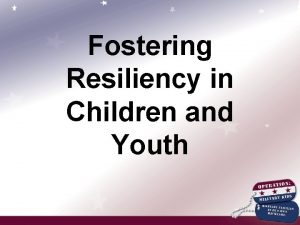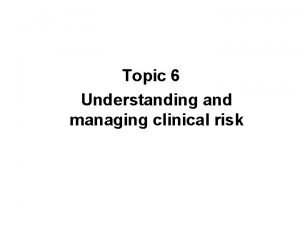Understanding Risk and Protective Factors Their Use in













- Slides: 13

Understanding Risk and Protective Factors: Their Use in Selecting Potential Targets and Promising Strategies for Interventions Copyright © 2014 by The University of Kansas

Risk and protective factors Aspects of a person or their environment that make it more or less likely they will experience a particular outcome. Copyright © 2014 by The University of Kansas

Categories of risk and protective factors • • • Personal Knowledge and skill Experience and history Biology/genetics Environmental Support and services Access, barriers, and opportunities Consequences of efforts Policies and living conditions Copyright © 2014 by The University of Kansas

Knowledge and skill • • Knowledge Beliefs Skill Education and Training Copyright © 2014 by The University of Kansas

Experience and History • Experience. • Cultural norms and religious practices. Copyright © 2014 by The University of Kansas

Biology and Genetics • • • Type and degree of existing health Cognitive, mental, or physical ability Chronic illness Gender and age Genetic predisposition Copyright © 2014 by The University of Kansas

Support and services • Availability of continuity of social support and ties. • Availability of appropriate services. • Availability of resources. Copyright © 2014 by The University of Kansas

Access, barriers, and opportunity • Physical access and barriers. • Communication access and barriers. • Competing requirements for participation. Copyright © 2014 by The University of Kansas

Consequences and effects • Incentives and disincentives. • Time costs and delays. Copyright © 2014 by The University of Kansas

Policies and living conditions • • Policies Financial barriers and resources Living conditions and hazards Poverty and social status Copyright © 2014 by The University of Kansas

General principles about risk and protective factors • Many factors are related to multiple community outcomes. • Not all risk and protective factors are created equal. • The more risk factors a person has, the greater the likelihood they will have a given health problem. Copyright © 2014 by The University of Kansas

When should you use risk and protective factors The sooner, the better! Copyright © 2014 by The University of Kansas

How do you identify risk and protective factors and use them to select the targets and strategies for your intervention? Review information about candidate factors. • Gather available data • Develop your own information • The "But why? " technique • Conduct focus groups • Develop and distribute surveys Select risk and protective factors to be addressed. • Does it strongly influence the issue? • Can it be easily changed? • What is the appropriate mix of risk and protective factors? • Use information about who is affected by multiple risk factors to help select your "targets of change. " Use information about the types of risk and protective factors to select promising strategies for the comprehensive intervention. Copyright © 2014 by The University of Kansas
 Credit risk market risk operational risk
Credit risk market risk operational risk Aces protective factors
Aces protective factors Resiliency wheel
Resiliency wheel Understanding and managing clinical risk
Understanding and managing clinical risk Understanding rigid transformations and their properties
Understanding rigid transformations and their properties Residual risk and secondary risk pmp
Residual risk and secondary risk pmp Business risk and financial risk leverage
Business risk and financial risk leverage Attributable risk formula
Attributable risk formula Measure of association formula
Measure of association formula Common risk factors in the returns on stocks and bonds*
Common risk factors in the returns on stocks and bonds* Risk factors of head and neck cancer
Risk factors of head and neck cancer Is wood abiotic or biotic
Is wood abiotic or biotic Abiotic factors and biotic factors
Abiotic factors and biotic factors Abiotic factors and biotic factors
Abiotic factors and biotic factors

























